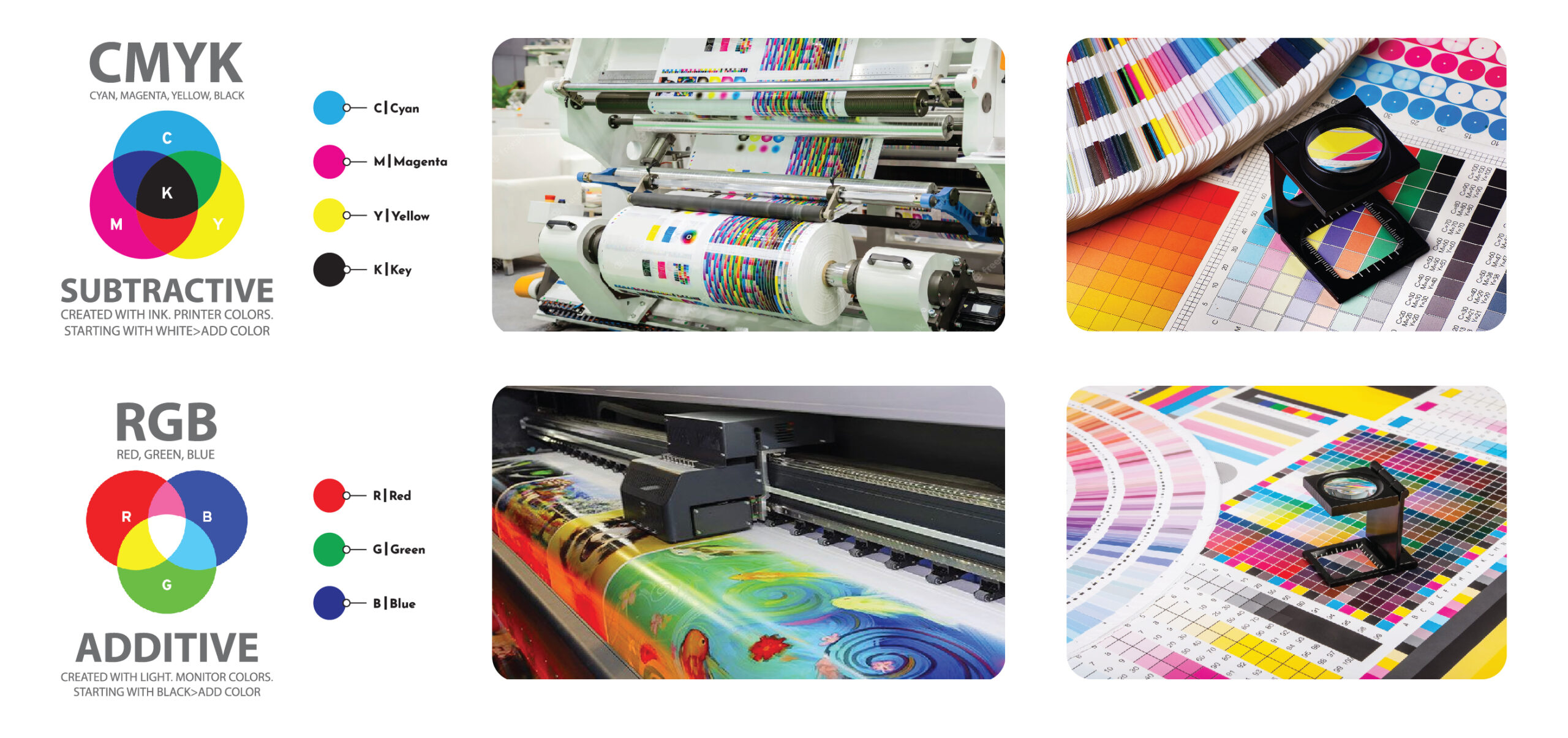In the printing and packaging industries, each of the CMYK and RGB color modes plays vital roles. But they serve special purposes. Understanding the difference among the two color modes and using them accurately ensures. That your designs look nice in both print and digital formats.
What is CMYK Color Model?
CMYK stands for Cyan, Magenta, Yellow, and Black. It is a color version are useful in printing and photo layout to symbolize and reproduce a considerable range of colors on physical materials, which include paper and different substrates. The CMYK color version is based totally on subtractive color blending, where every shade is deliver to a white substrate, and as extra shade is delivered, the end result gets darker, eventually leading to a black shade.
In CMYK, every color is show by a percentage ranging from 0% to 100%. When combined at full intensity, the four colors create a stable black coloration (Key) that’s commonly useful for textual content and first-rate information in print. For instance, to produce a bright pink shade, the printer may want to use high-potential magenta and yellow inks.
CMYK is the standard color model applied in expert printing techniques like offset printing, flexography, and digital printing. When designing artwork for print, it’s important to paint inside the CMYK coloration mode to make sure that the colors within the final printed product are similar to what’s seen at the show. Using CMYK facilitates accurate shade examples and consistency throughout numerous print materials, including brochures, flyers, packaging, and more.
Specifications of CMYK
The importance of CMYK in printing and packaging lies in its function because it uses the same old color model for reaching a correct and constant shade replica on bodily substances. Here are numerous reasons why CMYK is essential within the printing and packaging industries:
1. Color Accuracy: CMYK is specifically designed for subtractive shade mixing, which is the gadget applied in printing. It allows printers to reproduce a good-sized variety of colors effectively, making sure that the very last revealed product closely fits the intended shade inside the layout.
2. Color Consistency: By using the CMYK color version, printers can achieve certain consistency at some stage in a couple of print runs. This is specifically essential for manufacturers and corporations that require uniform packaging and advertising substances to maintain a cohesive logo picture.
3. Printing Capability: CMYK displays the inks are useful in the printing technique (cyan, magenta, yellow, and black), making it the most properly matched coloration model for numerous printing strategies, which include offset, virtual, and flexographic printing.
4. Cost-Effectiveness: CMYK printing is normally more cost-effective than the use of specialize inks, as it can attain a widespread spectrum of colors with just four popular inks. This makes it a sensible desire for mass manufacturing.
5. Versatility: CMYK is useful for a wide variety of print materials, which include brochures, flyers, product packaging, labels, and more. Its versatility makes it the go-to shade version for most printing packages.
6. Design and Prepress: Designing in CMYK ensures that designers work inside the printable color gamut and keep away from potential shade shifts or inaccuracies while transitioning from the display to print.
7. Compatibility with Printers: Most printing devices and software programs are designed to work with CMYK shade spaces, making them the industry s standard for print-equipped files.
With expertise and the usage of CMYK as it should be in printing and custom packaging boxes, companies can obtain first-rate, visually appealing, and consistent outcomes in their found materials. It guarantees that the colors appropriately represent the brand and merchandise, assisting in creating a tremendous and lasting effect on clients.
What is RGB Color Model?
RGB stands for Red, Green, and Blue. It is a color version mostly useful in digital imaging, photographs, and virtual simulations along with computer monitors, television video display units, and mobile gadgets. In the RGB coloration version, hues are created by combining precise intensities of crimson, green, and blue light. By varying the intensity of each of these three primary colorations, a massive range of colors can be produced at the show.
In the RGB model, every color is represented with the aid of a numeric value ranging from 0 to 255 for each of the primary colorings. For example, natural crimson is represented as (255, 0, 0), herbal green as (0, 255, 0), and pure blue as (0, 0, 255). When all three colorations are set to their maximum depth (255), the end result is pure white, and when all three are set to their minimum intensity (0), the result is herbal black.
Since RGB is an additive shade model, combining all 3 primary hues at their full intensity effects in white mild This is why laptop screens and extraordinary virtual suggestions emit light to create the colors we see, in contrast to printing on paper, which uses inks and the CMYK color model for color reproduction.
When running digital layout projects for displays or online media, it is critical to use the RGB color mode to make certain that colorations appear as intended on virtual devices. Using RGB allows for color accuracy and consistency in virtual imaging and ensures that the colors inside the final virtual output match what is seen on the show display.
Specifications of RGB
RGB is typically useful in digital shows and virtual media, but its significance in printing and packaging is sincerely confined in contrast to CMYK. While CMYK is the usual color version for printing, RGB nevertheless plays a role in certain aspects of the printing and packaging methods. Here are a few elements highlighting the significance of RGB in printing and packaging:
1. Digital Design and Previsualization: RGB is the coloration model useful for designing pictures and art work on digital gadgets, inclusive of computers and cell screens. Designers regularly paint in RGB while creating visible content material, collectively with packaging mockups, which lets them previsualize how the colors will appear on virtual presentations.
2. Digital Mockups and Presentations: RGB is usefu in virtual mockups and suggests revealing packaging designs to customers or stakeholders. These virtual representations assist in providing a clean visualization of how the packaging will appear on show display or in digital advertising materials.
3. Online Marketing and E-commerce: RGB performs a critical function in online marketing and advertising, wherein digital pictures of products, which incorporate packaging, are displayed on web sites, social media systems, and online shops. RGB ensures that the colors appear as intended on digital shows, improving the perceived attraction of the products.
4. Artwork Conversion: In some instances, artwork created in RGB may additionally need to be transformed to CMYK for printing. This conversion is performed during the prepress approach to make certain that the colors are as they should be translated from the RGB color vicinity to the CMYK color place for printing.
5. Branding Consistency: Brands that have a sturdy online presence may additionally use RGB color values to maintain consistency among their digital advertising materials and bodily packaging. By cautiously handling RGB to CMYK conversion, they’re capable of making sure that their brand shades remain steady across both digital and print systems.
Overall
Overall, at the same time as RGB is crucial for virtual layout, marketing, and marketing elements of packaging, it’s far more critical to understand the regulations of the usage of RGB in printing. To reap correct and steady coloration representation on bodily substances, it is crucial to convert RGB designs to CMYK before sending them for printing. This ensures that the final published packaging aligns with the supposed color palette and brand identity.
What is the Importance of Printing in Custom Box Packaging?
Printing in custom subject packaging holds massive importance for numerous reasons, as it performs an essential function in enhancing the general emblem picture and client revel in it. Here are some key reasons why printing is important in custom field packaging:
1. Brand Identity: Custom subject printing permits businesses to include their emblem, brand hues, and exceptional logo factors on the packaging. This permits the creation of a sturdy and consistent logo identification, making the packaging at once recognizable and reinforcing the brand’s presence in the market.
2. Product Differentiation: Custom printing lets corporations format unique and captivating packaging that sets their merchandise apart from the competition. The format can replicate the product’s features, story, or audience, making it more attractive to functionality clients.
3. Visual Appeal: High-pleasant printing complements the enchantment of the packaging, making it more appealing to clients. Vibrant shades, complex designs, and professional finishes can have an extremely positive and lasting impact on patron engagement and purchase.
4. Informative Communication: Custom field printing affords the possibility of communicating critical facts to clients. This consists of product data, usage commands, brand messaging, and any crucial criminal or safety information. Printing on the packaging guarantees that this data is easily accessible to customers.
5. Unboxing Experience: Well-published custom boxes can create a memorable unboxing experience for customers. Intriguing designs, snap shots, and messages construct anticipation and pleasure, improving patron pride and leaving an advantageous brand influence.
6. Marketing and Promotion: Custom area printing serves as an advertising and marketing tool, particularly for e-alternative corporations. Branded packaging acts as a cell billboard, selling the logo at some point of transit and even after delivery, even as customers reuse or recycle the packaging.
7. Consumer Perception: Custom boxes packaging with expert printing conveys a sense of brilliance and attention to detail. Customers regularly associate properly designed packaging with the top-notch internals of the product, influencing their perception of the brand.
8. Customer Loyalty: Thoughtfully designed custom packaging can foster a sense of loyalty and connection with the logo. Customers might also develop an emotional attachment to the packaging, encouraging repeat purchases and brand advocacy.
In conclusion
In conclusion, printing on custom field packaging is vital for brand differentiation, visual appeal, effective communication, and patron engagement. It goes beyond without a doubt protecting the product; it’s miles a powerful advertising device that enables corporations to create a wonderful brand identification and leave an enduring effect on clients, in the long run contributing to their fulfillment in the market. That is why it’s crucial to take a detailed look at the various color models utilized in printing packaging boxs.
Which Color Model is Suitable for Printing on Different Material of Custom Packaging Boxes, CMYK or RGB?
Here we have discussed commonly useful in custom box packaging materials and their suitable color models for printing.
Kraft Boxes
For Kraft boxes, the appropriate shade model is CMYK (Cyan, Magenta, Yellow, and Key/Black) for printing. Kraft boxes are usually fabricated from unbleached brown paperboard, and the CMYK color model is designed specially for printing on bodily materials like paper.
Color Model for Printing on Cardboard Boxes, CMYK or RGB?
For printing on cardboard boxes, an appropriate color model is CMYK (Cyan, Magenta, Yellow, and black). Similar to kraft boxes, cardboard boxes are also bodily substances are useful in packaging. And CMYK is mainly designed for attaining accurate and everyday color reproduction inside the printing process.
Suitable Color Model for Printing on Corrugated Boxes, CMYK or RGB?
For corrugated boxes, the proper color version is CMYK (Cyan, Magenta, Yellow, and black). Corrugated boxes are form from corrugated cardboard. Which is a bodily material useful in packaging, and CMYK is mainly designed for carrying out accurate. And regular shade replicas inside the printing method on such materials.
Which Color Model is better for Printing on Rigid Boxes, CMYK or RGB?
The appropriate color version is CMYK (Cyan, Magenta, Yellow, and black) for printing on inflexible boxes. Rigid boxes are generally form from sturdy substances like paperboard or chipboard. And are typically useful for luxurious or moderate-stop packaging. CMYK is particularly designed for achieving accurate and normal shade reproduction on physical materials like inflexible boxes.
Conclusion
CMYK (Cyan, Magenta, Yellow, and Key/Black) is the usual shade mode are useful for professional printing for custom-made boxes. It is based totally on subtractive shade blending. Wherein colorations are shown on a white substrate to create the favored colors. CMYK is good for printed substances like brochures, flyers, labels, and packaging. It efficaciously reproduces a massive range of colors, together with those that fall within the printable gamut of the chosen printing system.
On the other hand, RGB (Red, Green, and Blue) is an additive color mode for is useful virtual displays. Together with PC monitors, mobile devices, and TVs. In RGB, colorations are produce by using light, and it is first-class appropriate for virtual applications. Like web sites, social media photographs, and virtual advertising. RGB can show a broader spectrum of colors as compared to CMYK. But it may not represent high-quality sunglasses that fall outside the printable variety of CMYK in print applications.
In precis, at the same time as each CMYK and RGB have their precise roles. CMYK is the principle coloration mode in the printing and custom printed packaging enterprise. For engaging in accurate color reproduction on physical materials. RGB remains the preferred choice for virtual programs. Due to its capacity to show a far wider variety of hues on video display units. Understanding the distinctions between the two shade modes and their usage accurately ensures that your designs look great. In both print and digital codecs. According to the collective information from different Packaging Manufacturing Companies. Dawn Printing is one of the paragon company of US which allows you to choose the color modes for your custom printed boxes.
























